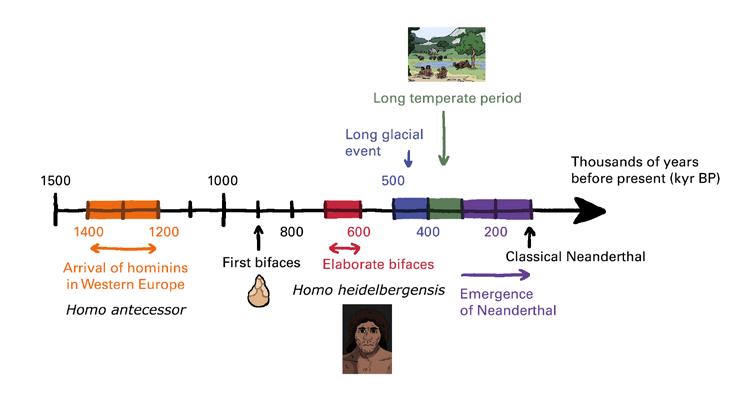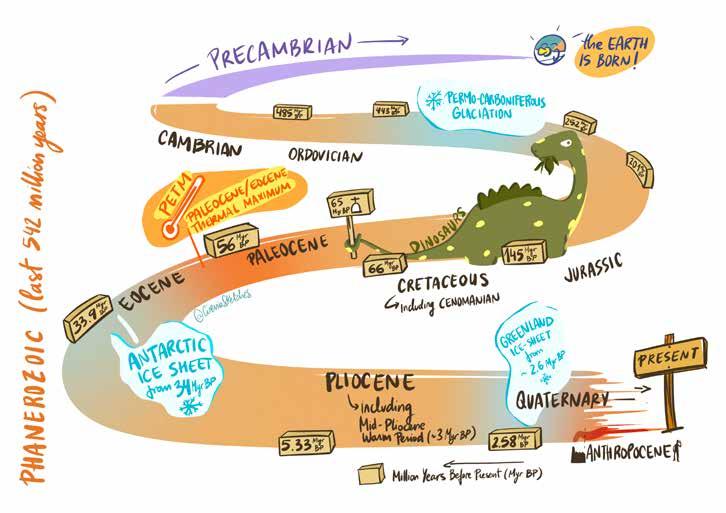
8 minute read
Warm climates in the deep past
Gilles Ramstein; Illustrations: Cirenia Arias Baldrich The warming of our planet is quickly becoming an existential concern. The burning of fossil fuels (coal, gas, and petroleum), produces a rapid increase in the atmospheric concentration of carbon dioxide (CO2), which is a greenhouse gas*. The impact that human activity has on the warming of our planet is undeniable and leads to unprecedented climate changes. However, for most of our geological history, the Earth experienced warmer climates associated with higher levels of CO2 and higher sea levels compared to those of today. Interestingly, they can be compared to those that planet Earth will experience in the near future.
Figure 1 Timeline of the Phanerozoic era (last 542 million years). Myr BP = million years before present.
Advertisement
We are warming our planet at an alarming rate and in a very unusual context. Today, we have two large ice sheets*: Greenland and Antarctica. Over geological time, the existence of ice sheets was very rare. To better understand this, let’s look at what has been happening on the scale of millions of years and put it into the context of our planet’s climate history.
To explore the conditions of the deep past, i.e. before the Quaternary* (2.5 million years), we use data from solar insolation, tectonics, and atmospheric CO2 concentration reconstructions as input for climate models. There is a diverse range of climate models, which vary in complexity, but all aim to compute the spatial variation of temperature and precipitation.
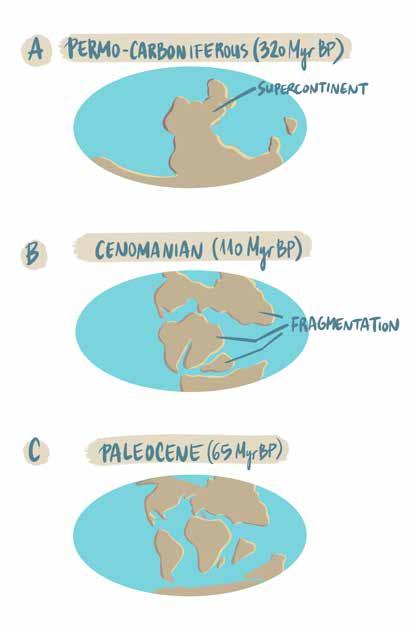
Traveling back into the deep past
The Phanerozoic era corresponds to the last 542 million years (Fig. 1) and begins with the explosion of life in the Cambrian. During this era, several glaciations are recorded, for example during the Ordovician or Permo-Carboniferous. Exceptional periods of glaciation occurred during the Jurassic and Cretaceous. The last massive glaciation took place 300 million years ago, when large continental land masses were located around the South pole (Fig. 2a). The atmospheric concentration of CO2 was low enough to allow for the formation of an ice sheet. However, for most of Earth's history, there were no ice sheets. A well-known example is the time of the dinosaurs, which appeared 250 million years ago and disappeared 65 million years ago (Fig. 1): 185 million years largely without ice sheets (Fig. 2b).
Until 34 million years ago, there were no ice sheets, barring some rare, exceptional events. There are two possible explanations for this: either there was no continent at the poles or sub-polar locations where it is was cold enough for ice to have formed; or that the climate was warm enough, with a high atmospheric concentration of greenhouse gases, leading to the rapid melting of winter snowfall during summertime.
The crucial role of paleogeography
There are specific periods, for example the Cenomanian (100 million years ago), for which the temperature distribution is more uniform (Fig. 3). Compared to today, the thermal gradient from equator to pole (i.e. the difference between the average temperatures at high and low latitudes in each hemisphere) was much flatter, with much higher temperatures at the poles. Moreover, tropical and subtropical plants could be found at very high latitudes, and temperature differences between summer and winter were reduced. All these characteristics describe a very different climate to that of today: much more uniform across space and time.
About 65 million years ago, the continents were separated into several landmasses (Fig. 2c). The continent of Antarctica was already in a polar location. However, no ice sheet existed at that time because the atmospheric CO2 content was very high: about 1500 ppm compared with 416 ppm today (2021) and about 280 ppm before industrialization during the 19th century. The absence of an ice sheet was due to the melting of winter snow instead of its accumulation year after year, which would allow an ice sheet to form. The sea level was then much higher than today.
Figure 2 Paleogeography for three different periods: (A) the Permo-Carboniferous, which was the last period of long and extensive glaciation, dating from 320 million to 270 million years ago; (B) the ice-free Cenomanian (Cretaceous), 100 million years ago; (C) the Paleocene, 65 million years ago.
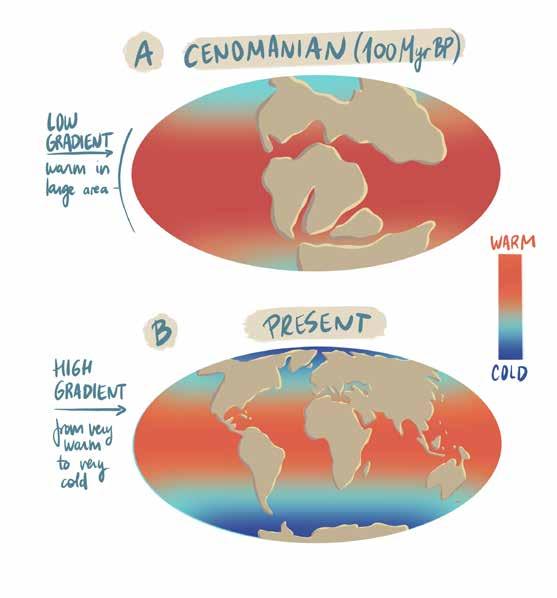
Scientists have highlighted exceptional warming events, which occurred during some of the already warm periods throughout climate history. The most spectacular one, the Paleocene-Eocene Thermal Maximum, happened about 56 million years ago at the frontier between the geological periods known as the Paleocene and Eocene (Fig. 1), when a drastic atmospheric CO2 change, with pCO2 more than eight times higher than pre-industrial* levels (Fig. 4), destabilized the already warm climate. This warmer climate event lasted about 200,000 years, and is sometimes depicted as a parallel to our current global warming period because it corresponds to a big, sharp and fast modification in the carbon cycle, with a major impact on the temperature of the Earth. There are several key differences between this period and today:
First, the Paleocene-Eocene Thermal Maximum took place in a warmer world than today with higher CO2 atmospheric concentration: about 1,200 ppm compared to around 420 ppm today. It is interesting to note that by 2100 we might also reach very high pCO2 values. But as there was no ice sheet before the Paleocene-Eocene Thermal Maximum, there was no risk of major sea-level rise at that time. These comparisons make it a fascinating period to study.
Second, the speed of change was at least 10 times slower than the recent and ongoing human-driven CO2 and temperature increases.
Third, the tectonics of the Earth during the Eocene also played a major role in the global climate: changing mountains, ocean bathymetry, and seaways, which were different to those of today. For instance, this period corresponds to the large uplift of Tibetan Plateau due to collision between Indian and Asian plates. Some important seaways were closed, such as the Drake passage, but others were opened, e.g. the Central American seaway.
A gradual cooling from the Eocene to the end of the Pliocene*
Figure 3 Schematic of the temperature from the equator to the poles during (A) the Cenomanian (mid-Cretaceous) and (B) the present-day periods. The difference between the equator and pole temperatures (gradient) is low at the Cenomanian and high at the present.
From the Eocene until the Pliocene-Quaternary transition (2.52 million years ago), atmospheric CO2 concentration decreased to about 300 ppm, while temperatures also gradually decreased (Fig. 4). This cooling took more than 40 million years, which gives us a timescale of the Earth's climate processes. Despite the cooling, the climate remained warmer than the last interglacial periods of the Quaternary, including the present one.
The climate of the midPliocene Warm Period (~3 million years ago) has been simulated in great detail by climate models (see Capron and Bouttes p. 68). These simulations were carried out in the context of 3 million years ago; different models were compared. The models were then either validated/ invalidated by comparing the climate reconstruction to existing data. Climate models
have found a global temperature rise of 2–3°C warmer than preindustrial temperatures. Indeed, the paleogeography of this period is comparable to ours. The most prominent difference is that the sea level was 10–25 m (30–80 ft) higher. This can be explained by an important reduction of the Greenland and West Antarctica ice sheets, as well as loss of ice from areas along the margin of the East Antarctic Ice Sheet. This situation is perfectly consistent with the idea that, with a high value of pCO2 over a long timescale, the most vulnerable ice sheets (Greenland and the western part of Antarctica) can melt entirely. This would represent an equivalent sea-level rise of approximately 10–12 m (33–39 ft).
However, as helpful as it is to compare such models, it is also important to take into account the differences. The most significant difference is that the present warming of our planet is not in equilibrium. When the world is warming, the ice sheets and deep ocean need thousands of years to reach equilibrium. The ice sheets and oceans are not in equilibrium with the climate because of inertia effects, which mean that they are several thousands of years slower in reaction compared to surface climate warming, which can occur over hundreds of years.
A few more possible insights from past climate simulations?
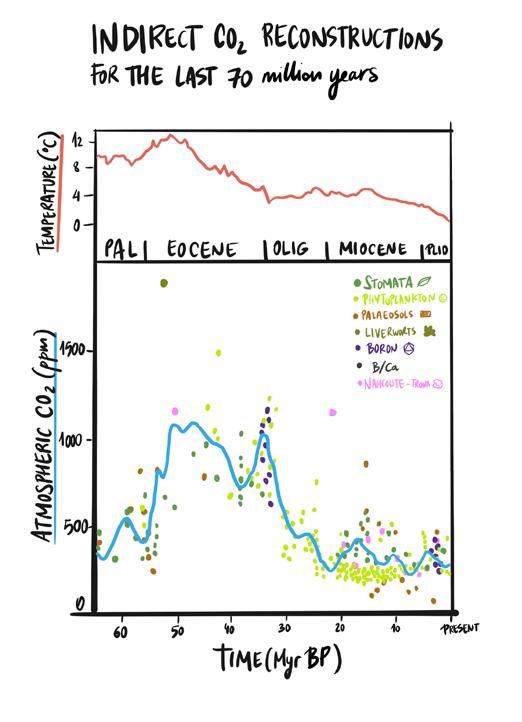
For all the warm climate periods described above – the Cenomanian, Eocene, and Pliocene – climate models tend to underestimate the temperatures reconstructed for high latitudes. Climate models often fail to capture the flat profile of the thermal gradient from equator to pole, shown in Figure 3. This problem was first discovered in the 1980s with simpler climate models, but even today with much more sophisticated models, the problems persist. Over the next century, the climate of the high latitudes will change drastically as the ice sheet progressively melts and the sea ice* shrinks, or disappears. In turn, this will lead to major changes in the climate of the lower latitudes. It is difficult to predict what impact the melting ice sheets will have on the global climate. Nor do we know how the atmosphere and the oceans, which redistribute heat from the warm equator to the cold poles, will respond. This issue is crucial for a better understanding of our future climate, and will certainly be a focus for a new generation of researchers. And the fascinating deep past remains one of the best ways to address the question!









